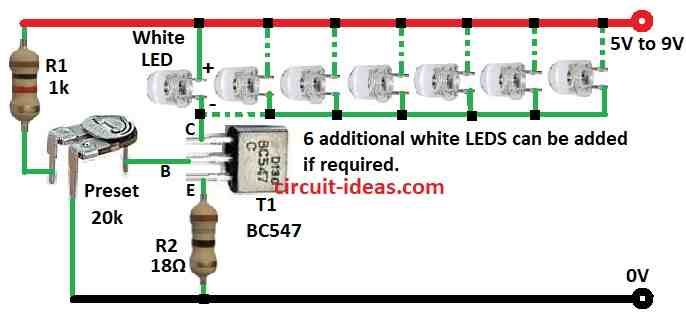LEDs, or light-emitting diodes, are extensively employed in a variety of applications because of their effectiveness, durability, and adaptability.
In applications ranging from ornamental lighting to signaling reasons, controlling the brightness of an LED can be crucial.
An NPN transistor BC547, resistors, a variable resistor (preset), and a white LED are used in this adjustable brightness control circuit for LEDs.
Users may seamlessly control the LEDs brightness thanks to this circuit.
Circuit Working:

Note: 20mA is the current of one white LED.
7 LEDs at 20 mA each means a total current of 140 mA.
Transistor T1 current rating should not be exceeded by total current.
Parts List:
| Component | Value | Quantity | Power Rating |
|---|---|---|---|
| Resistor | 1k | 1 | 1/4 watt |
| Resistor | 18Ω | 1 | 1/4 watt |
| Preset Resistor | 20k | 1 | |
| Transistor | BC547 | 1 | |
| LED white | 5mm 20 mA | 1 |
The voltage across the preset resistor controls the BC547 transistor, which acts as a switch in the LED adjustable brightness control circuit.
The DC supply used to power the circuit has a voltage range of 5V to 9V.
A modest current given to the base of the NPN transistor BC547 causes current to flow from collector to emitter.
The transistor is able to regulate a higher current passing through the LED because of this little control current.
The base current may be changed using the preset resistor 20k.
The base current may be changed by varying the resistance, which will alter the amount of current passing through the LED and modify its brightness.
While the 18Ω resistor limits the current of the LED to safeguard it, the 1k resistor restricts the base current to shield the transistor.
Formulas:
Below mentioned are the formulas for simple adjustable brightness control circuit for LEDs:
1: Ohms Law:
V = IR
where,
- V is the voltage,
- I is the current, and
- R is the resistance.
2: Transistor Current Gain:
IC = β x IB
where,
- IC is the collector current
- IB is the base current,
- β is the current gain hFE of the transistor.
3: LED Current Calculation:
The power supply voltage and series resistance can be taken into account when calculating the maximum current through the LED:
ILED = Vsupply − VLED / Rtotal
where,
- VLED is the forward voltage drop across the white LED
- Rtotal=18Ω+RLED
How to Build:
To build a Simple Adjustable Brightness Control Circuit for LEDs following steps need to follow for connections:
- Gather all the components as mentioned in the above mentioned circuit diagram:
- Connect collector of transistor BC547 to positive supply through white LED.
- Connect base of transistor BC547 to middle leg of preset VR1.
- Connect emitter of transistor BC547 to GND through resistor R2.
- Connect in series from positive supply to Gnd a resistor R1 and preset VR1.
- Connect preset VR1 upper leg to positive supply, middle leg to base of transistor BC547, and last leg to GND.
Conclusion:
This LED intensity control circuit uses a variable resistor and a basic NPN transistor to provide a simple yet effective means of adjusting the brightness of a white LED.
The circuit has several uses, including ornamental displays, indication lights, and mood lighting.
Users may create a range of brightness levels by adjusting the preset resistors base current, which makes this a useful option for regulating the intensity of LEDs in practical applications and DIY projects.
Leave a Reply